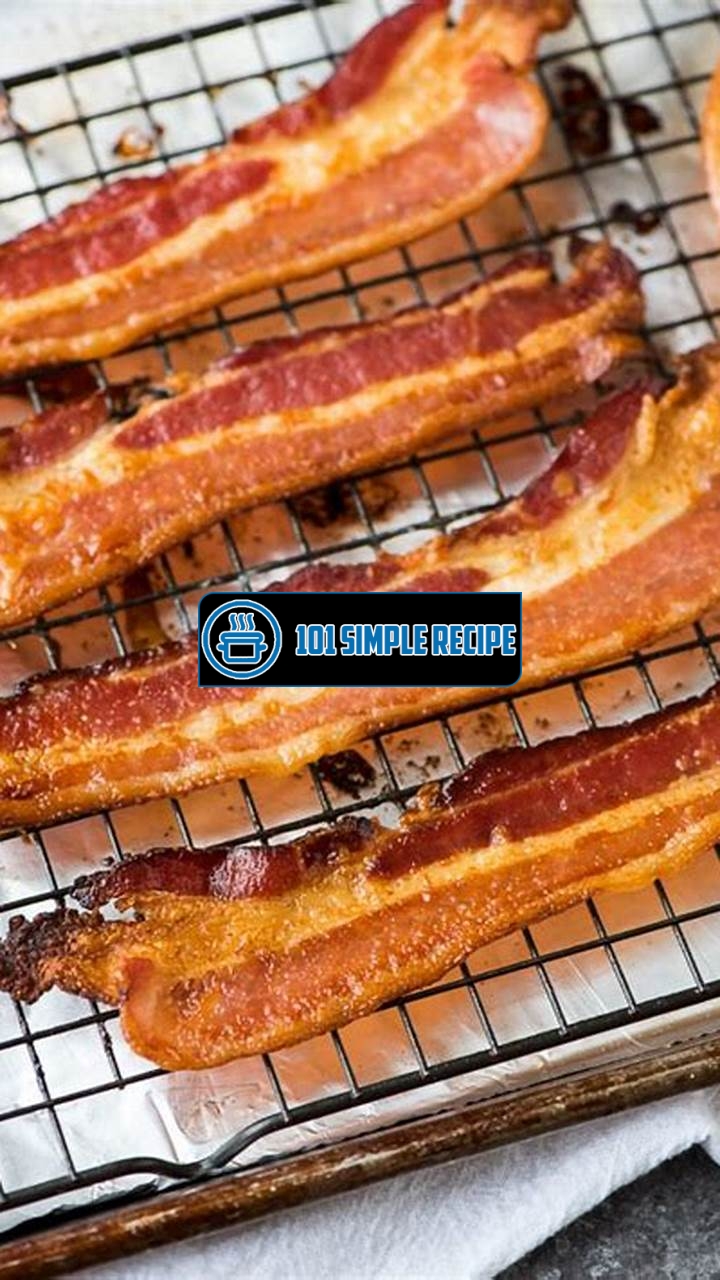Are you tired of making a greasy mess every time you cook bacon on the stovetop? Look no further, because we have the perfect solution for you! In this article, we will teach you how to master the art of baking bacon in the oven, resulting in perfectly crispy strips with minimal effort and cleanup. Say goodbye to sizzling hot oil splatters and say hello to a hassle-free way of enjoying your favorite breakfast treat. So get ready to elevate your bacon game to a whole new level!

Understanding Baking Bacon in the Oven
Discover the benefits and techniques of baking bacon instead of frying it on the stovetop.
The Advantages of Baking Bacon
Gone are the days of standing over a hot stove, constantly flipping bacon to achieve a crisp and evenly cooked result. Baking bacon in the oven is a game-changer, offering several advantages over the traditional stovetop method.
First and foremost, baking bacon eliminates the need for constant attention. Once you pop the bacon in the oven, you can walk away and focus on other tasks. This means you can prepare the rest of your breakfast or multi-task while your bacon cooks to perfection.
Another advantage of baking bacon is the reduced mess. When frying bacon on the stovetop, grease can splatter and create a greasy mess on your stovetop, countertops, and even your clothes. By baking bacon in the oven, you eliminate the risk of oil splatters and make cleanup a breeze.
Additionally, baking bacon allows for a more even cooking process. When you fry bacon in a pan, it can curl up and cook unevenly, resulting in some pieces being burnt while others remain undercooked. In the oven, the bacon lies flat and cooks evenly, ensuring that every slice is crispy and delicious.
Lastly, baking bacon is a healthier alternative to frying. When bacon is fried on the stovetop, it sits in its own fat, leading to a higher calorie and fat content. Baking bacon allows some of the fat to render off, resulting in a lighter and less greasy final product.
Choosing the Right Bacon
Now that you understand the advantages of baking bacon, it’s essential to choose the right type of bacon for oven preparation. Not all bacon is created equal, and different varieties may yield different cooking results.
When selecting bacon for baking, opt for thick-cut slices. Thick-cut bacon holds up better in the oven and provides a meatier, more substantial bite. Thinly sliced bacon tends to become overly crispy and can easily burn.
It’s also crucial to consider the quality of the bacon. Look for bacon made from high-quality pork and without added preservatives or artificial ingredients. Organic or pasture-raised bacon is an excellent choice for those seeking a more natural and flavorful option.
Lastly, consider the flavor profile you desire. Bacon comes in various flavors, such as applewood-smoked, maple, or hickory. Experiment with different varieties to find your favorite taste combination.
Preparing the Bacon for Baking
Once you’ve chosen the perfect bacon for baking, it’s time to prepare it for the oven. Prepping the bacon ensures optimal cooking and flavor.
Start by preheating your oven to 400°F (200°C) for the best results. While the oven preheats, line a baking sheet with parchment paper or aluminum foil to make cleanup easier.
Next, lay the bacon slices on the prepared baking sheet, ensuring they don’t overlap. This allows the bacon to cook evenly and prevents the slices from sticking together. For extra flavor, you can sprinkle some black pepper or brown sugar over the bacon.
Place the baking sheet in the preheated oven and let the bacon cook for about 12-15 minutes, or until it reaches your desired level of crispiness. Keep a close eye on the bacon during the last few minutes to prevent burning.
Once cooked to perfection, remove the bacon from the oven and transfer it to a plate lined with paper towels. Let the excess grease drain before serving, and enjoy your perfectly baked bacon!
If you’re looking for more delicious recipes, check out this cookie in a mug recipe. It’s a quick and easy dessert that you can make in just a few minutes.
EQUIPMENT: The Essentials for Baking Bacon
Achieving the perfect oven-baked bacon requires the right tools and equipment. Let’s explore the necessary items you’ll need to master the art of baking bacon in the oven.
Baking Sheets and Racks
To start off, you’ll need a good quality baking sheet or rack. Opting for a sturdy, heavy-duty baking sheet will ensure even heat distribution and prevent the bacon from sticking. A rimmed baking sheet is ideal for trapping any excess grease that renders out during baking. This will prevent any messy oven spills and make cleanup a breeze.
Remember, using a baking rack can elevate your bacon, allowing the hot air to circulate around it and yield crispy, evenly cooked strips.
Parchment Paper or Aluminum Foil
Next, consider using parchment paper or aluminum foil to line your baking sheet. Both options have their advantages. Parchment paper provides a non-stick surface, making it easier to remove the bacon once it’s cooked. It also helps absorb some of the excess grease, resulting in a crispier texture.
On the other hand, aluminum foil offers easy cleanup as it can be disposed of after use. It also helps to contain the rendered fat, reducing the risk of smoke or splattering.
Whichever option you choose, lining your baking sheet will prevent the bacon from sticking and eliminate the need for excessive cleaning.
Tongs or Spatula for Handling
Lastly, you’ll want to have a reliable pair of tongs or a spatula for handling the bacon. These tools come in handy when flipping the strips halfway through the cooking process and removing them from the baking sheet.
Using tongs or a spatula ensures that you can safely handle the hot bacon without risking any burns.
Another point to consider is the material of your tongs or spatula. Opting for heat-resistant silicone or stainless steel will ensure they withstand the high oven temperatures without melting or warping.
All in all, having the right equipment simplifies the process of baking bacon in the oven. Remember to choose a suitable baking sheet or rack, consider using parchment paper or aluminum foil for easy cleanup, and have tongs or a spatula on hand for safe handling. With these essentials in your kitchen arsenal, you are well on your way to mastering the art of baking bacon in the oven!
If you’re a dog owner, you’ll love this dog food recipe. It’s made with natural ingredients and is a healthy option for your furry friend.
PREPARATION: Steps for Baking Bacon
Follow a step-by-step process to ensure crispy and delicious bacon every time.
Preheating the Oven
To start baking bacon in the oven, you need to preheat your oven. Set the temperature to 400°F (200°C) and allow it to fully preheat. Preheating the oven ensures that the bacon cooks evenly and becomes crispy. This step is crucial for achieving the perfect texture and taste.
Arranging the Bacon
Once the oven has reached the desired temperature, it’s time to arrange the bacon on a baking sheet. Line the baking sheet with aluminum foil or parchment paper to make cleaning up easier afterwards. You can also place a wire rack on top of the baking sheet to elevate the bacon and allow the excess grease to drip down.
Take each strip of bacon and lay it flat on the baking sheet, making sure they don’t overlap. Leaving enough space between the strips will allow the hot air to circulate, resulting in evenly cooked bacon. It’s important to arrange the bacon with care and precision to avoid any uneven cooking or unwanted chewy spots.
Monitoring and Flipping the Bacon
Now comes the most crucial part of baking bacon in the oven – monitoring and flipping it while it cooks. After about 10-12 minutes of baking, check on the bacon to assess its doneness. Using tongs or a fork, carefully flip each strip of bacon to ensure it cooks evenly on both sides.
Note: Flipping the bacon midway through the cooking process is essential for achieving perfectly crispy bacon. It allows the bacon to cook evenly and prevents one side from becoming too crispy while the other remains undercooked.
Continue baking for another 10-12 minutes, checking on the bacon periodically. Pay close attention to the color and texture. When the bacon reaches your desired level of crispiness, it’s ready to be removed from the oven.
Once the bacon is done, use tongs or a fork to transfer it from the baking sheet to a paper towel-lined plate. This step helps absorb any excess grease, resulting in a less greasy and more enjoyable bacon-eating experience. Let the bacon cool for a few minutes before serving.
Tip: To add a touch of extra flavor, you can sprinkle some black pepper or brown sugar on top of the bacon before baking. However, be cautious with the sugar as it can cause the bacon to burn more easily.
By mastering the art of baking bacon in the oven, you ensure a hassle-free and delicious cooking experience. Remember to preheat the oven, arrange the bacon on a baking sheet, and monitor and flip it during the cooking process. With these simple steps, you’ll have perfectly crispy bacon that is sure to impress your family and friends.
TIPS AND TRICKS: Mastering Oven-Baked Bacon
When it comes to cooking bacon, baking it in the oven is a game-changer. Not only does it result in crispy, evenly cooked bacon, but it also saves you the hassle of dealing with grease splatters on the stovetop. In this article, we will share expert tips and tricks to help you master the art of baking bacon in the oven. Whether you’re a bacon enthusiast or just looking for a convenient way to cook it, these tips will elevate your baking skills and ensure you make the best bacon possible.
Add Extra Flavor with Seasonings
Baking bacon in the oven doesn’t mean you have to settle for plain and boring strips. You can easily add extra flavor and enhance the taste of your bacon by using seasonings. Consider sprinkling some black pepper, garlic powder, or paprika on top of the bacon before placing it in the oven. This simple step will take your bacon to a whole new level of deliciousness. Don’t be afraid to get creative with your seasonings and experiment with different flavors to find your favorite combination.
Try Different Bacon Varieties
When it comes to bacon, there’s more than just the standard hickory-smoked variety. Why not explore different bacon options and find the one that suits your taste buds? Some popular varieties include applewood-smoked, maple-flavored, and peppered bacon. Each type offers a unique taste and can add a new dimension to your dishes. Whether you prefer a sweeter flavor or a spicier kick, trying different bacon varieties will add excitement to your meals and make your baking experience even more enjoyable.
How to Store and Reheat Baked Bacon
Once you’ve mastered the art of baking bacon in the oven, you may find yourself with leftovers. To ensure that your delicious bacon stays fresh and retains its flavor, it’s important to store it properly. After baking the bacon, let it cool down and then store it in an airtight container in the refrigerator. When you’re ready to enjoy it again, simply reheat it in the oven or microwave. Remember to place the bacon on a paper towel to absorb any excess grease.
To wrap it up:
- Enhance the flavor of your bacon by using seasonings such as black pepper, garlic powder, or paprika.
- Explore different bacon varieties, such as applewood-smoked, maple-flavored, or peppered bacon, to add variety to your meals.
- Properly store and reheat baked bacon to ensure it stays fresh and tasty. Store it in an airtight container in the fridge and reheat it in the oven or microwave.
Mastering the art of baking bacon in the oven is all about getting creative with flavors, exploring different options, and ensuring it stays fresh. With these expert tips and tricks, you’ll be able to take your bacon game to the next level and impress your friends and family with perfectly cooked, flavorful strips of bacon.
COMMON MISTAKES: Avoiding Pitfalls in Baking Bacon
When it comes to cooking bacon, the oven can be your best friend. Not only does it make the process more hands-off, but it also results in perfectly crispy and evenly cooked bacon strips. However, there are a few common mistakes that people often make when baking bacon that can lead to less-than-ideal results. By learning about these pitfalls and how to avoid them, you can master the art of baking bacon in the oven and enjoy delicious, crispy bacon every time.
Overcrowding the Baking Sheet
One of the most important things to remember when baking bacon is to avoid overcrowding the baking sheet. It can be tempting to pile on as many bacon strips as possible to save time, but this can prevent the bacon from cooking properly. When the bacon is overcrowded, the strips can end up steaming rather than crisping, resulting in chewy and greasy bacon. To achieve optimal results, make sure to give each strip enough space on the baking sheet. This will allow the bacon to cook evenly and become nice and crispy.
Using High Oven Heat
Another common mistake is using high oven heat when baking bacon. While it may seem like a good idea to crank up the heat for faster cooking, this can lead to burnt or overly crispy bacon. The high heat can cause the fat to render too quickly, resulting in bacon that is overly crispy or even burnt around the edges. To avoid this, it’s best to bake bacon at a moderate temperature, around 400°F (200°C). This will allow the bacon to cook evenly and retain its moisture for a perfect balance of crispiness and chewiness.
Not Monitoring the Cooking Time
Lastly, many people make the mistake of not monitoring the cooking time when baking bacon. Bacon can go from perfectly crispy to burnt in a matter of minutes, so it’s important to keep a close eye on it as it cooks. Start checking on the bacon around the 12-minute mark to see how it’s progressing. Keep in mind that cooking times may vary depending on the thickness of the bacon and your desired level of crispiness. Once the bacon reaches your desired level of doneness, remove it from the oven and transfer it to a paper towel-lined plate to absorb any excess grease.
By avoiding these common mistakes and following these tips, you can become a master at baking bacon in the oven. Remember to give the bacon enough space on the baking sheet, use a moderate oven temperature, and keep a close eye on the cooking time. With practice, you’ll be able to achieve perfectly crispy and delicious bacon every time. Happy baking!
For a tasty snack, try these ranch oyster crackers. They’re crispy, savory, and perfect for snacking on the go.
Thank you for reading our article on baking bacon in the oven. We hope you found the information helpful and that you’ll come back to visit us again soon. Whether you’re a bacon lover or just looking for a new way to cook breakfast, baking bacon in the oven is a game-changer. It’s easy, convenient, and yields perfectly crispy bacon every time. Plus, it frees up your stovetop for other dishes. So why not give it a try? Your taste buds will thank you.
Frequently Asked Questions
Here are some commonly asked questions about baking bacon in the oven:
| No. | Questions | Answers |
|---|---|---|
| 1. | Can you cook bacon in the oven? | Yes, baking bacon in the oven is a great alternative to frying it on the stovetop. It’s less messy and results in crispy, evenly cooked bacon. |
| 2. | What temperature do you bake bacon in the oven? | Preheat your oven to 400°F (200°C) for perfectly cooked bacon. |
| 3. | How long does it take to bake bacon in the oven? | The baking time can vary depending on the thickness of the bacon slices, but it usually takes around 15-20 minutes. |
| 4. | Do you need to flip the bacon when baking? | No, there’s no need to flip the bacon while baking. Just place it on a baking sheet and let the oven do its magic. |
| 5. | How do you keep bacon from splattering in the oven? | To prevent splattering, you can line the baking sheet with aluminum foil or parchment paper. This also makes cleaning up a breeze. |
| 6. | Can you save the bacon grease? | Absolutely! Bacon grease can be saved and used for cooking or adding flavor to other dishes. Just strain it and store it in a jar in the refrigerator. |
Closing Thoughts
We hope this article has inspired you to give baking bacon in the oven a try. It’s a simple and foolproof method that will elevate your bacon game to a whole new level. Say goodbye to greasy stovetops and hello to perfectly crispy bacon strips. Remember, the key to success lies in the right temperature and timing, so follow the instructions closely. And don’t forget to experiment with different seasonings and flavors to make your bacon truly unique. Happy baking!
Jump to Recipe
Baking Bacon in Oven

Learn how to bake bacon in the oven and achieve perfectly crispy results every time. Say goodbye to splattering grease and hello to an easier cooking method!
- 1 pound bacon
- Preheat your oven to 400°F (200°C).
- Line a baking sheet with aluminum foil or parchment paper. Arrange the bacon strips in a single layer on the sheet.
- Place the baking sheet in the preheated oven and bake for 15-20 minutes, or until the bacon is crispy and browned to your liking.
- Carefully remove the baking sheet from the oven and transfer the bacon strips to a paper towel-lined plate to drain excess grease.
- Serve the bacon hot and crispy. It’s now ready to be enjoyed!






